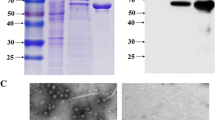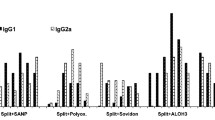Summary
Recombinant Hantaan virus nucleocapsid protein (rNP) and recombinant envelope (rEnv) proteins were prepared using a baculovirus expression system to examine the role of Hantaan virus structural proteins in protective immunity. Passive transfer of spleen cells from mice immunized with rNP conferred partial protection or prolongation of time to death from fatal Hantaan virus infection in suckling mice which were challenged with Hantaan virus at 40 LD50 (survival rate: 43%) or 4 LD50 (survival rate: 43%). The T cell-enriched fraction protected one mouse from lethal infection but the B cell-enriched fraction had no such effect on fatal HTN infection. The protective effects of the antibody against HTN challenge were examined by passive immunization. The monoclonal antibody ECO 2 directed to NP also conferred partial survival and significant difference in time to death. Although rEnv antigen failed to induce neutralizing antibody, both immune spleen cells and immune serum to rEnv conferred partial protection upon suckling mice. These results indicate that both nucleocapsid and envelope proteins of Hantaan virus were responsible for induction of cell mediated protective immunity. Vero E 6 cells infected with Hantaan virus expressed envelope protein on the surface, as determined by flow cytometry. However, there was only negligible expression of nucleocapsid protein.
Similar content being viewed by others
References
Arikawa J, Schmaljohn AL, Dalrymple JM, Schmaljohn CS (1989) Characterization of Hantaan virus envelope glycoprotein antigenic determinants defined by monoclonal antibodies. J Gen Virol 70: 615–624
Arikawa J, Yao J-S, Yoshimatsu K, Takashima I, Hashimoto N (1992) Protective role of antigenic site on the envelope protein of Hantaan virus defined by monoclonal antibodies. Arch Virol 126: 271–281
Asada H, Balachandra K, Tamura M, Kondo K, Yamanishi K (1989) Cross-reactive immunity among different serotype of virus causing haemorrhagic fever with renal syndrome. J Gen Virol 70: 819–825
Asada H, Tamura M, Kondo K, Dohi Y, Yamanishi K (1988) Cell-mediated immunity to virus causing haemorrhagic fever with renal syndrome: generation to cytotoxic T lymphocytes. J Gen Virol 69: 2179–2188
Asada H, Tamura M, Kondo K, Okuno Y, Takahashi Y, Dohi Y, Nagai T, Kurata T, Yamanishi K (1987) Role of T lymphocyte subsets in protection and recovery from Hantaan virus infection in mice. J Gen Virol 68: 1961–1969
Azuma I, Ogawa Y, Igari Y, Ukei S, Numata F, Yamamura Y (1986) Antitumor activity of quinonyl-MDP-6 on line 10 hepatoma in strain 2 guinea pigs. In: Tohno S (ed) Immunochemotherapy of cancer. Hirosaki University School of Medicine, Hirosaki, pp 4–14
Carbone FR, Bevan MJ (1990) Class I-restricted processing and presentation of exogenous cell-associated antigen in vivo. J Exp Med 171: 377–387
Chiba N, Takashima I, Arikawa J, Hashimoto N (1984) Preparation of complement fixation antigen ofChlamydia psittaci grown in tissue culture by treatment of β-propiolactone. Microbiol Immunol 28: 1273–1281
Dharakul T, Labbe M, Cohen J, Bellamy AR, Street JE, Mackow ER, Fiore L, Rott L, Greenberg HB (1991) Immunization with baculovirus-expressed recombinant rotavirus protein VP 1, VP 4, VP 6, and VP 7 induced CD 8+ T lymphocytes that mediated clearance of chronic rotavirus infection in acid mice. J Virol 65: 5928–5932
Elliott RM (1990) Molecular biology of the Bunyaviridae. J Gen Virol 71: 501–522
Erb P, Grogg D, Troxler M, Kennedy M, Fluri M (1990) CD 4+ T cell-mediated killing of MHC class II-positive antigen presenting cells. I. Characterization of target cell recognition by in vivo or in vitro activated CD 4+ killer T cells. J Immunol 144: 790–795
Calisher CH (1991) Bunyaviridae. In: Francki RIB, Fauquet CM, Kundson DL, Brown F (eds) (1991) Classification and nomenclature of viruses. Arch Virol [Suppl] 2: 273–283
Gravelle M, Ochi A (1989) The targeting of CD 4+ T lymphocytes to a B cell lymphoma. J Immunol 142: 4079–4084
Grosfeld H, Velan B, Leitner M, Cohen S, Lustig S, Lachimi B-E, Shafferman A (1989) Semliki Forest virus E 2 envelope epitopes induce a nonneutralizing humoral response which protects mice against lethal challenge. J Virol 63: 3416–3422
Hioe CE, Hinshaw VS (1989) Induction and activity of class II-restricted, Lyt-2+ cytotoxic T lymphocytes specific for the influenza H 5 hemagglutinin. J Immunol 142: 2482–2488
Ikuta K, Morita C, Miyake S, Ito T, Okabayashi M, Sano K, Nakai M, Hirai K, Kato S (1989) Expression of human immunodeficiency virus type 1 (HIV-1) gag antigen on the surface of a cell line persistently infected with HIV-1 that highly expresses HIV-1 antigens. Virology 170: 408–417
Lee HW, Lee PW, Baek LJ, Chu YK (1990) Geographical distribution of haemorrhagic fever with renal syndrome and Hantaan virus. Arch Virol [Suppl] 1: 5–18
Lee HW, Lee PW, Johnson KM (1978) Isolation of etiologic agent or Korean haemorrhagic fever. J Infect Dis 137: 298–308
Luckow VA, Summers MD (1988) Signals important for high level expression of foreign genes inAutographa californica nuclear polyhedrosis virus expression vectors. Virology 167: 65–71
Morrison LA, Braciale VL, Braciale TJ (1985) Expression of H-21 region-restricted cytolytic acitivity by an Lyt-2+ influenza virus-specific T lymphocyte clone. J Immunol 135: 3691–3698
Nakamura T, Yanagihara R, Gibbs CJ, Amyx HL, Gajdusek DC (1985) Differential susceptibility and resistance of immunocompetent and immunodeficient mice to fatal Hantaan virus infection. Arch Virol 86: 109–120
Nakamura T, Yanagihara R, Gibbs CJ, Gajdusek DC (1985) Immune spleen cellmediated protection against fatal Hantaan virus infection in infant mice. J Infect Dis 151: 691–697
Rock KL, Gamble S, Rothstein L (1990) Presentation of exogenous antigen with class I major histocompatibility complex molecules. Science 249: 918–921
Ruo SL, Sanchez A, Elliott LH, Brammer LS, McCormick JB (1991) Monoclonal antibodies to three strains of hantaviruses Hantaan, R 22, and Puumala. Arch Virol 119: 1–11
Schmaljohn CS, Arikawa J, Dalrymple JM, Schmaljohn AL (1989) Expression of the envelope glycoprotein of Hantaan virus with vaccinia and baculovirus recombinants. In: Kolakofsky D, Mahy BWT (eds) Genetics and pathogenicity of negative strand viruses. Elsevier, Amsterdam New York, pp 58–66
Schmaljohn CS, Chu Y-K, Schmaljohn A, Dalrymple JM (1990) Antigenic subunits of Hantaan virus expressed by baculovirus and vaccinia virus recombinants. J Virol 64: 3162–3170
Schmaljohn CS, Hasty SE, Harrison SA, Dalrymple JM (1983) Characterization of Hantaan virions, the prototype virus of haemorrhagic fever with renal syndrome. J Infect Dis 148: 1005–1011
Schmaljohn CS, Sugiyama K, Schmaljohn AL, Bishop DHL (1988) Baculovirus expression of the small genome segment of Hantaan virus and potential use of the expressed nucleocapsid protein as a diagnostic antigen. J Gen Virol 69: 777–786
Tanishita O, Takahashi Y, Yamanishi K, Takahashi M (1984) Evaluation of focus reduction neutralization test with peroxidase-antiperoxidase staining technique for haemorrhagic fever with renal syndrome virus. J Clin Microbiol 20: 1213–1215
Yamada A, Ziese MR, Young JF, Yamada YK, Ennis FA (1985) Influenza virus hemagglutinin-specific cytotoxic T cell response induced by polypeptide produced inEscherichia coli. J Exp Med 192: 663–674
Yanagihara R, Gajdusek DC (1987) Haemorrhagic fever with renal syndrome; global epidemiology and ecology of hantavirus infection. In: de la Maza LM, Peterson EM (eds) Medical virology VI. Elsevier, Amsterdam, pp 171–214
Yasukawa M, Inatuki A, Horiuchi T, Kobayashi Y (1991) Functional heterogeneity among herpes simplex virus-specific human CD 4+ cells. J Immunol 146: 1341–1347
Zhang X-K, Takashima I, Hashimoto N (1989) Characteristics of passive immunity against hantavirus infection in rats. Arch Virol 105: 235–246
Author information
Authors and Affiliations
Rights and permissions
About this article
Cite this article
Yoshimatsu, K., Yoo, YC., Yoshida, R. et al. Protective immunity of Hantaan virus nucleocapsid and envelope protein studied using baculovirus-expressed proteins. Archives of Virology 130, 365–376 (1993). https://doi.org/10.1007/BF01309667
Received:
Accepted:
Issue Date:
DOI: https://doi.org/10.1007/BF01309667




